Living the High Life
Geology is a wonderful reason for travel. In contrast to many scientific disciplines, geologists typically go to the field for their primary data. In the past few years William & Mary geologists have conducted field research from Peru to the Arctic, from desert mountain ranges in Arizona to tidal estuaries in Portugal. Our field research sites also span the Commonwealth of Virginia from the Blue Ridge Mountains to the marshes on Jamestown Island.
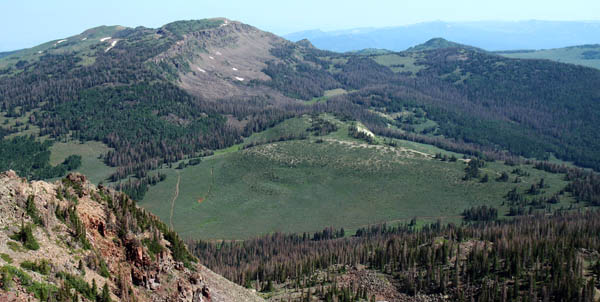
The view from the top of Utah’s Fish Lake Plateau
I’m a geology professor specializing in tectonics, and, truth be told, most anything that interests me relating to the Earth. In this first posting I hope to provide a picture of geological field research experiences at William & Mary. Just what exactly do geologists do in the field? We, myself and three W&M undergrads, have just returned from three weeks of fieldwork on the High Plateaus in Utah. The High Plateaus region divides Utah into roughly two halves, separating the stark Basin & Range landscape to the west from the colorful canyonlands of the Colorado Plateau on the east. Seventy million years ago this region was a low coastal plain at sea level, but over the past fifty million years central Utah was uplifted at least two vertical miles producing a set of distinctive plateaus that top out above 11,000 feet. Our research goal is to understand how and when the High Plateaus got high.
Our research in Utah has been supported by the Charles Center @ W&M, the National Science Foundation, and for the 2008 field season the U.S. Geological Survey. In the last few years we’ve demonstrated that faults have both uplifted and torn apart the Fish Lake Plateau, we’ve determined the age and extent of past glaciations on the Plateau, and we’ve used geophysical methods to reveal the depth and thickness of sediments in Fish Lake itself.
This summer our team includes three rising seniors at the College; Trevor Buckley’s research is focused on the fault geometry and tectonic history, JoBeth Carbaugh is working to determine the age and environmental setting for the underlying sedimentary rocks, and Graham Lederer, a Blue Ridge geologist, has enlisted to carry rocks, plot data, and generally be useful. A crew of geologists from Western State College in Gunnison, Colorado is also collaborating with us.
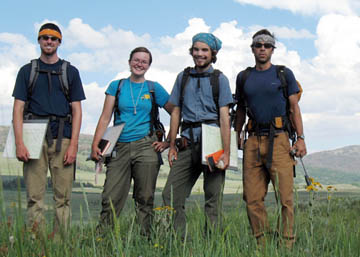
William & Mary field team 2008
Life in the Field
Simply put we spend our days trying to map out the underlying geologic structures. In the end we’ll produce a geologic map and cross sections of the Fish Lake Plateau that will be used to help answer the when and how questions. We also collect rocks that, under a microscope or in a mass spectrometer, will reveal their secrets. Field mapping involves hiking, lots of hiking. Not so much on trails, but wherever we need to go; a typical day involves 6 to 10 miles of walking with a few thousand feet of ups and downs as well. We plot our position and geologic observations on maps and enter that data into GPS receivers. In camp the data is downloaded to generate digital maps. Our days start at sunrise with the clank of the hot water kettle on the camp stove. In the field we watch as the brilliant blue morning skies fill with puffy clouds that, seemingly without provocation, turn gray and menacing. When the thunder rumbles and the rain comes in sheets we hunker down. The meadows are a bloom with flowers and cowpies; elk and deer are common in the aspen forests. At day’s end, Fish Lake helps to wash the grime away. Fieldwork has given us farmer’s tans for which there is no remedy.
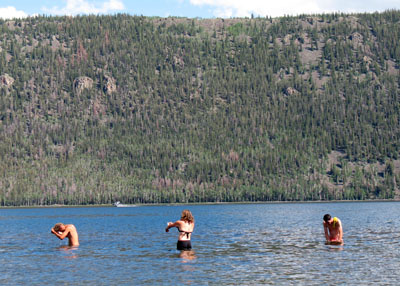
A fine day for bathing in Fish Lake
Early morning departure on a sleepy Saturday morning from Williamsburg, our flights get us into Salt Lake City before sunset, the rental vehicle gets us to Fish Lake in the middle of the night. I crawl into the sleeping bag at midnight, a starry sky unfurls overhead.
8 July
Trevor and I make a first traverse into Pete’s Hole and live to tell about it. It is a curious landscape in which everything seems askew- it’s all just a bit tilted, fault scarps are clear and impressive. Streams are working to erode the southern end of the Hole, but the basin is not yet integrated by erosion, oh my!

Field sheet from the Pete’s Hole area, note Utah quarter for scale
10 July
Examining the pre-volcanic sediments with personnel from the Utah Geological Survey. Determining the age of the strata is a challenge; perhaps the claystones will yield ancient pollen, the limestones microscopic fossils, or the sandstones pieces of vertebrates that can be harnessed to “date” these rocks.
Last night’s rain cleaned out the atmosphere and we awoke to a sharp and clear sky. Time to climb Mt. Marvine (a.k.a. The Blade or Sawtooth); the highest peak in our study area. The main ridge is a steep prow of rock underlain by layer upon layer of volcanic rock. We approach from the northwest, hike around to the east face, clamber up a steep boulder field and then transit onto bedrock to reach the ridgeline, from there a few steep pitches put us at the top of the battlement-like summit. We admire the outstanding view and collect samples. By dinner everybody is hungry and the mood festive. Tonight’s menu includes- chorizo, corn and rice burritos. In a superhuman effort, Graham swallows at least 10 burritos, after which he meekly retorts “las tortillas del maíz eran muy pequeñas”
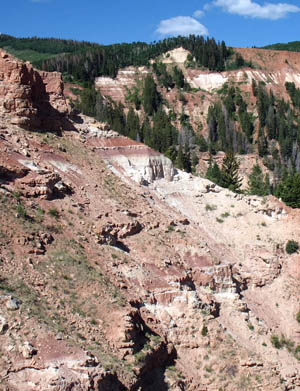
Sedimentary rocks exposed in Red Creek Hole
22 July
Into Red Creek Hole we go to measure stratigraphic section (a tedious endeavor). Puffy clouds at 9 a.m.- this looks bad. By noon the first raindrop falls, by 1 p.m. a thunderstorm spits hail and pins us along a ridge. Do we stay or do we go? When the thunder rolls in close, we retreat downhill, muddy rivulets pour over the slopes and we work downward much as a skier cuts turns. Finish with a long muddy walk to vehicles- fortunately the roads are still passable and we regroup back in camp.
23 July
Last day of fieldwork- we are a bit field weary, but the day proves to be gorgeous. JoBeth and Trevor successfully measure the strata in Red Creek Hole; Graham and I trace volcanic layers and find more faults. It’s a good day to be living the high life.

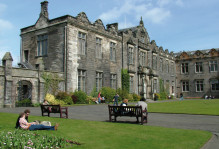
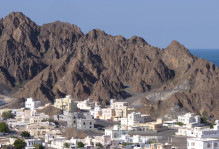
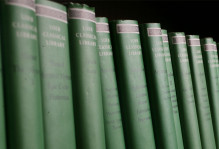
No comments.
Comments are currently closed. Comments are closed on all posts older than one year, and for those in our archive.